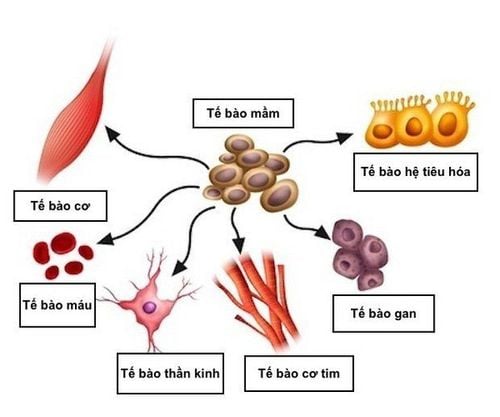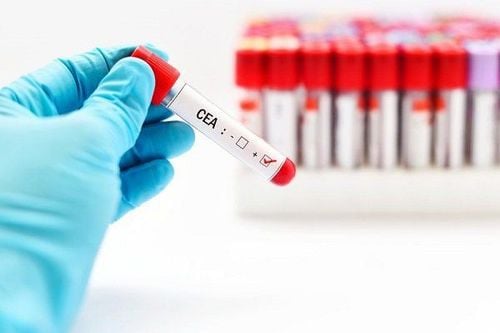This is an automatically translated article.
Patients with cancer often have a high risk of death, due to the fact that patients come too late for examination and treatment. Therefore, early cancer screening and screening play a very important role in reducing the risk of death for patients with these cancers.1. What is a tumor marker test?
Tumor markers, also known as cancer markers, are substances produced by cancer cells or other cells of the body in response to cancer or certain benign diseases. Normally, cancer markers are still secreted by normal cells of the body, but the amount of these substances will be greatly increased in patients with cancer. The components that make up cancer markers are usually large protein molecules with added sugars or fats (glyco, lipoproteins), synthesized by cancer cells and often present in blood and water. urine, feces, tumor tissue and other tissues, or in body fluids in concentrations proportional to tumor growth.Recently, gene expression traits and DNA changes have also begun to be used as cancer markers. These cancer markers are highly specific for each cancer organization. To date, more than 50 different cancer markers have been identified and used clinically. A few are associated with only a single type of cancer, while others are associated with two or more different types of cancer.
An ideal cancer marker should have two characteristics:
One is sensitivity (Sensibility, Se) which is the smallest concentration that can be quantified when a tumor turns malignant: Has a sensitivity of up to 100% and false The false negative number is 0%, which means that it can be detected very early in the early stages of cancer and is not missed. The second is the specificity (Specificity, Sp) which is the ability to separate each tumor type: with a specificity of 100% and a false-positive error of 0%, that is, only giving positive results when detecting cancer. In fact, there is no cancer marker that achieves the above two ideal criteria, so it is necessary to have an experienced specialist for analysis, accurate diagnosis and safe and effective treatment.
Tumor marker test is a test used to diagnose, identify, and screen some cancers early before symptoms appear, but in some cases the content of these cancer markers is elevated. not secreted by cancer cells but due to another disease.
In addition, the diagnosis of cancer based on the tumor marker test is also affected by local factors, meaning that not everyone with cancer also has an increased amount of cancer markers related to this type of cancer. Therefore, to accurately diagnose these cancers, besides using tumor marker test results, doctors need to combine other clinical and laboratory results such as biopsy, imaging image...
2. Values of cancer markers

Các marker ung thư có giá trị trong việc phát hiện,chẩn đoán và theo dõi điều trị một số bệnh ung thư
Pre-treatment quantification of cancer markers helps treating physicians to plan treatment fit. In some cancers, the amount of a cancer marker reflects the stage (spread) of the disease and the patient's prognosis (stage and outcome). Periodic measurement of cancer markers during cancer treatment to monitor and check the effectiveness of treatment. After stopping treatment, the quantification of cancer markers helps to monitor and detect recurrence of cancer diseases acquired at that time.
3. Important cancer markers in use today
ALK gene rearrangement: Non-small cell lung cancer, large cell lymphoma. Alpha-fetoprotein (AFP): Liver cancer (HCC), germ cell cancer. Beta-2-microglobulin (B2M): Multiple myeloma, lymphocytic leukemia, some lymphomas. Beta-hCG: Choriocarcinoma, testicular cancer. BCR-ABL: Medullary Leukemia. V600E BRAF mutation: Skin melanoma, colon cancer. CA 15.3/CA 27.29: Breast cancer CA 19.9: Pancreatic cancer, colon cancer, some digestive cancers (gallbladder, bile duct, stomach) CA 125: Ovarian cancer. Calcitonin: Thyroid medullary cancer. Calretinin: Mesothelioma, sex cord-gonadal stromal tumor, adrenocortical carcinoma, synovial sarcoma. Carcinoembronic antigen (CEA): Gastrointestinal cancer, cervical cancer, lung cancer, ovarian cancer, breast cancer, urinary tract cancer. CD 20: Non-Hodgkin's Lymphoma. CD 34: Hemangiopericytoma/solitary fibrous tumor,pleomorphic lipoma, gastrointestinal stromal tumor,dermatofibrosarcoma protuberans. CD45(PTPRC): Lymphoma, leukemia, histiocytic tumor. CD 117: Gastrointestinal stromal tumor, mastocytosis, seminoma. Chromogranin A: Neuroendocrine tumor. Chromosomes 3,7,17 and 9p21: Bladder cancer. Cytokeratin fragment 21-1(CYFRA 21-1): Lung cancer Desmin: Smooth muscle sarcoma, rhabdomyosarcoma, endometrial stromal sarcoma. Epithelial membrane protein (EMA): Many types of sarcoma, meningioma, many types of carcinoma. EGFR mutation analysis: Non-small cell lung cancer. Estrogen receptor/Progesterone receptor: Breast cancer Fibrin/Fibrinogen: Bladder cancer. Factor VIII, CD 31 FL1: Vascular sarcoma. Glial fibrillary acidic protein (GFAP): Glioma (astrocytoma, ependynoma) Gross cystic disease fluid protein (GCDFP-15): Breast cancer, ovarian cancer, salivary gland cancer. HE4: Ovarian cancer HER2/neu: breast cancer, stomach cancer, esophageal cancer. HMB45: Melanoma, PEComa (eg, angiomyolipoma), clear cell carcinoma, adrenocortical carcinoma. Immunoglobulin: Multiple myeloma (Kahler's disease), Waldenstrom's disease. Inhibin: Sex cord-gonadal stromal tumor, adrenocortical carcinoma, hemangioblastoma. KRAS mutation analysis: Colon cancer, non-small cell lung cancer. KIT: Gastrointestinal stromal tumor, mucosal melanoma. Lactate dehydrogenase (LDH): Germ cell cancer. MART-1(Melan-A): Melanoma, steroid-induced tumor (adrenocortical carcinoma, hemangioblastoma). MyoD1:Rhabdomyosarcoma, small, round, blue cell tumor. Muscle-specific-actin (MSA): Myosarcoma (smooth muscle sarcoma, rhabdomyosarcoma).
CA 125 giúp phát hiện ung thư buồng trứng
4. Common signs of cancer today

AFP là chất chỉ dấu ung thư của ung thư gan (HCC) và ung thư tế bào mầm
AFP is a plasma protein found in high concentrations in fetal blood. Normally, an AFP protein is made by immature liver cells in the fetus. Physiologically, in the first year of life, at birth, newborns have relatively high blood levels of AFP, which gradually decrease to a low normal level. Healthy, non-pregnant adults often have very low blood levels of AFP (not exceeding 10 ng/ml). AFP is a tumor marker of hepatocellular carcinoma (HCC) and germ cell carcinoma. However, AFP is also elevated in normal pregnant women and in some benign liver diseases (hepatitis, cirrhosis...). Human chorionic gonadotropin (HCG)
Is a glycoprotein hormone produced during pregnancy by the newly conceived embryo and later, by syncytiotrophoblast (part of the placenta). Both men's and women's lobes also produce an HCG-like substance called luteinizing hormone (LH). HCG interacts with the LHCG receptor and initiates the maintenance of the corpus luteum during early pregnancy, causing them to produce the hormone progesterone. This hormone gives the uterus a dense system of blood vessels and capillaries to maintain the development of the fetus. Much like LH, HCG is also used clinically to induce ovulation in the ovaries as well as testosterone production in the testes. HCG also plays a role in cell differentiation/proliferation and can activate apoptosis. HCG can be used as a tumor marker of some cancers such as seminoma, choriocarcinoma, germ cell tumor, oocyte, teratoma, islet cell tumor and testicular cancer. In combination with AFP, HCG is an excellent cancer marker for germ cell tumor monitoring.

HCG có thể được sử dụng như chất chỉ dấu ung thư của một số ung thư
Although first detected in colon cancer, elevated CEA levels are not specific for colon cancer nor for cancers in general. In addition to colon cancer, CEA is also elevated in pancreatic, stomach, lung, and breast cancers. CEA is also elevated in some benign diseases such as cirrhosis, inflammatory bowel disease, chronic lung disease, and pancreatitis. CEA was also increased in 19% of smokers and 3% of normal healthy controls. While not sufficient to screen for cancer in healthy populations, CEA is widely used to monitor recurrences such as pancreatic, gastric, lung (non-small cell), thyroid, and lung cancers. ENT or C-cell cancer because it can herald recurrence for months. Prostate-specific antigen (PSA): is a glycoprotein secreted by epithelial cells of the prostate gland, which has the function of loosening semen clots, enabling sperm to swim freely in semen. It is also believed that PSA thins cervical mucus, making it easier for sperm to penetrate.
In normal people, the amount of PSA in the blood is very low, so the PSA level is high, suggesting that the patient may have prostate cancer. However, there are also cases of patients with prostate cancer but the PSA level does not increase (false negative). ). Most of the PSA in the blood is bound to proteins, except for a very small amount called free PSA. In men with prostate cancer, the ratio of free PSA to total PSA (f PSA/t PSA) decreased. The risk of prostate cancer increases if the ratio is less than 25%. The lower the ratio, the higher the risk of prostate cancer. CA 125: is an antigen present in 80% of ovarian cancers, CA 125 is a cancer marker detected by the monoclonal antibody OC125 produced by immunizing mice with ovarian cancer cells. human eggs. CA125 circulates in the patient's blood and is therefore used as a marker of cancer.
CA125 is a cancer marker widely used in the detection and monitoring of cancers of the reproductive system in women, including uterine, fallopian tube and ovarian cancers. CA125 is also elevated in pancreatic, lung, breast and colon cancers. However, it should be noted that CA125 is also elevated in pregnant or menstruating women, as well as in some noncancerous conditions such as ovarian cysts, pericarditis, hepatitis, cirrhosis, and peritonitis. and even in 1-2% of the average person. In cases where cancer has been diagnosed, the amount of CA 125 is considered an indicator of the effectiveness of the treatment. CA15.3: is usually elevated in breast cancer but is also elevated in many non-cancerous diseases such as cirrhosis, benign diseases of the breast and ovaries.
CA19.9: increased in 21-42% of gastric cancer cases, 20-40 colon cancer cases, 71-93% pancreatic cancer cases.
CA 72.4: found in fetal epidermal cells. The amount of CA 72.4 in a normal adult is about 2-4 IU/ml.
CA72.4 is a highly specific cancer marker. CA 72.4 is increased in gastric cancer. Combined with CEA, this test has high sensitivity and specificity. CA72.4 is also elevated in ovarian cancer. But sometimes, in cases of benign inflammation, CA 72.4 levels also increase to 7 IU/ml
5. Ways to prevent cancer
Measures to prevent cancer include:Environment and diet: Polluted environment, unreasonable diet is also one of the causes of cancer in our country and other countries around the world. gender. Stop smoking to avoid lung cancer for yourself and those around. Avoid eating foods such as: peanuts, moldy beans, melons because this is one of the agents that can cause liver cancer. Protect the environment green, clean and beautiful, keep the atmosphere always fresh. Vaccination against cancer The best way to prevent cancer is still to have regular health check-ups twice a year and treat related diseases. Exercise every day for about 30 minutes in the morning with gentle, moderate exercises such as walking, yoga,... For those who are overweight, obese need to lose weight, reduce the amount of fat in their body. body.

Đối với những người bị thừa cân, béo phì cần phải giảm cân, giảm lượng chất béo trong cơ thể
Customers can directly go to Vinmec Health system nationwide for examination or contact the hotline here for support
MORE:
What are tumor markers? Can a cancer diagnosis ever be wrong? Significance of CEA quantification for cancer markers













